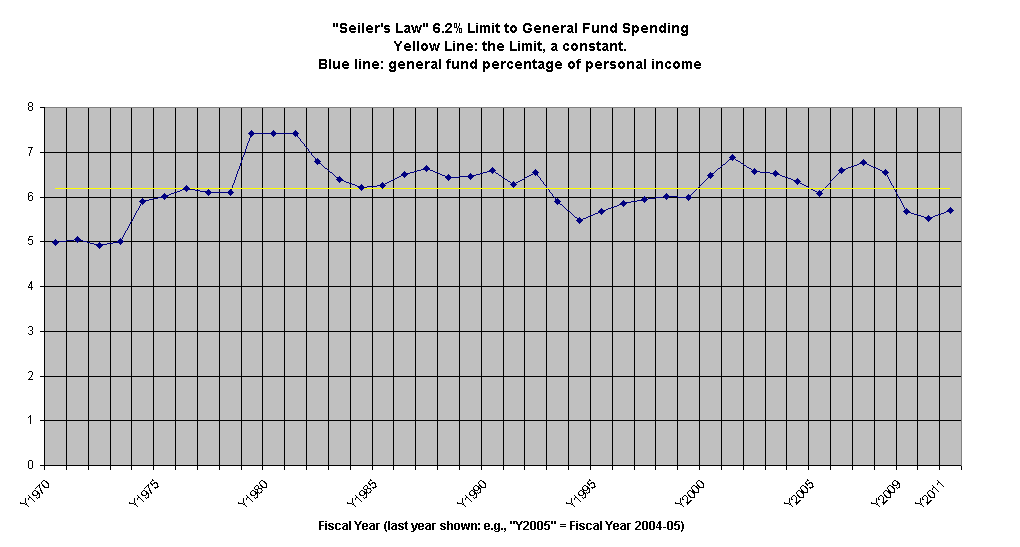CA budget tops sensible limits
by CalWatchdog Staff | May 27, 2010 9:20 am

MAY 27, 2010
By JOHN SEILER
Budget time. So I thought I would revisit an analytical tool I devised a few years ago to help better understand the California state budget.
Back in the early 2000s, I was pouring over state government budget documents and noticed something peculiar: whenever state general-fund spending rose above 6.2 percent of personal income, the state budget went into deficit. But so long as the general-fund spending stayed below 6.2 percent, things were OK.
It was sort of like a speed limit: Go beyond it and you get in trouble.
I wrote some articles on it for the Orange County Register, where I was an editorial writer. I then called it “the 6.2 percent solution” (to California’s budget problem). The name was a play on Sherlock Holmes’ 7 percent solution of cocaine he was addicted to, and for which he was cured by Sigmund Freud in the 1976 movie, “The Seven Percent Solution[1].”
In early 2005, Tom Campbell[2], then the budget director for Gov. Schwarzenegger (and now running for U.S. Senate), visited us for an editorial board meeting. I showed him the graph.
“That’s Seiler’s Law,” Campbell said. “Like Moore’s Law[3] in computing.” And I’ve kept the name ever since. The only earlier version of this analysis still online I did for for Jon Fleischman’s Flashreport[4] three years ago, before the economy fell apart and the deficits soared.
Here’s the graphic I showed Campbell, updated to the 2010-11 budget, as proposed by Gov. Schwarzenegger:

The data through fiscal 2009-10, ending this June 30, come from the governor’s January budget proposal[5], Section 6, Appendix Page 13, second column from the right.
And the revenue numbers for the next fiscal year come from the governor’s May Revise[6]: A projected $91.5 billion in general-fund spending (p. 9) and personal income of $1,608.8 billion (p. 54).
It should be noted that the governor’s proposed numbers likely will be changed in the actual budget adopted later this year. But this estimate is good enough for now.
A little budget history
To understand where we are today with that 5.7 percent number for the proposed fiscal 2010-2011 budget, which currently is below Seiler’s Law, let’s first go through the budget history of the past 40 years. Look again at the graph above.
The first time the budget went over the 6.2 percent limit was in the early 1980s, as the Gann Limit[7], passed by voters in November 1979, was kicking in, limiting spending increases to the increases in inflation plus population growth. Spending then leveled off through the rest of the 1980s, only a little above the 6.2 percent limit.
The budget was so tamed that in 1987 the state government refunded $1.1 billion to taxpayers.
Then, in 1990, voters passed Proposition 111, which was sold as a way to build more roads. In fact, it effectively gutted the Gann Limit.
The recession of the early 1990s forced budget cuts that kept the budget below the 6.2 percent limit. But the dot-com boom of the late 1990s brought incredible growth in tax receipts, leading Gov. Gray Davis — and the Legislatures of those days — to go on a spending binge.
In his first two budgets, for fiscal years 1999-2000 and 2000-2001, Davis jacked up spending an incredible 15 percent per year — each year.
In fiscal year 2000-01, the budget ratio shot up to 6.88 percent, way above the 6.2 percent limit.
It couldn’t last. It didn’t last. Davis quickly was running deficits of $40 billion a year, a major factor in his recall in 2003.
Schwarzenegger promised to do better, and for his first couple of years, he did. The ratio dropped below 6.2 percent by fiscal year 2005-06, even though this was a time of prosperity and rising tax receipts. Then, after losing getting wiped out with slate of four reform initiatives in November 2005, Schwarzenegger changed.
In his January 5, 2006 State of the State address[8], he announced:
I have absorbed my defeat and I have learned my lesson. And the people, who always have the last word, sent a clear message – cut the warfare, cool the rhetoric, find common ground and fix the problems together. So to my fellow Californians, I say, “Message received.”
The “message” Democratic Legislature received was: “I surrender.”
Soon, he was going on a Davis-style spending binge. The budget ratio raced up above the 6.2 percent limit. In Fiscal Year 2006-07, it soared to 6.78 percent. At the time, I predicted massive deficits would return once the economy turned sour.
The ongoing Great Recession hit in 20o8, producing the predictable deficits. To his credit, the governor cut spending last year (along with counterproductive tax cuts) to bring the ratio down below 6.2 percent.
Where we are now
As the budget battle ensues, it’s well to see why the 6.2 percent limit exists. It’s not numerology. It’s just the natural limit of spending the people of California will bear.
It’s like piling straw on a camel’s back. Stay below the 990 pounds most camels can carry[9], and you can cross a desert. But add the proverbial “final straw” to the camel’s back and it collapses, leaving you to die of thirst far from an oasis. For California, the “straw that broke the camel’s back” is anything above the 6.2 percent limit.
That’s why tax increases, such as the record $13 billion last year, are so futile. The problem is that spending is so high.
Why the dip in the ratio?
A final methodological question remains: During a recession, as tax receipts drop, why is it necessary for the ratio to drop below the 6.2 percent ratio for a few years to bring the budget into balance? Why not just settle for cutting the budget to exactly the 6.2 percent ratio?
I puzzled over this for a while, and recently came up with the reason: It’s like blowing too much money in your family budget, say on an expensive vacation, by maxing out your credit cards. Afterward, you have to cut back for months, even years, to get your family budget back in the black.
Next time, if you’re smart, you’ll skip the trip to Paris and instead take the family to the Grand Canyon. If you don’t, your credit rating drops and you face bankruptcy — just like the state does today.
For the state, the binges of wild spending must be followed by the purges of cutting spending below the 6.2 percent limit.
But there’s good news. In the future, if the state makes sure it never goes above the 6.2 percent limit, then it won’t have massive budget deficits followed by painful cuts.
If it did so, surpluses again would happen. But instead of splurging on them, as Davis and Schwarzenegger did, some of the surplus tax receipts should be put in a “rainy day fund,” the rest refunded to taxpayers, who, after all, pay for everything.
If the extra money is used for more spending, then we would just repeat the budget roller coaster — and the pain of periodic cuts — of the past 20 years.
Seiler’s Law: It’s a limit we can live with.
John Seiler, an editorial writer with The Orange County Register for 19 years, is a reporter and analyst for CalWatchDog.com. His email: [email protected].
- The Seven Percent Solution: http://en.wikipedia.org/wiki/The_Seven-Per-Cent_Solution
- Tom Campbell: http://en.wikipedia.org/wiki/Tom_Campbell_(California_politician)
- Moore’s Law: http://en.wikipedia.org/wiki/Moore's_law
- I did for for Jon Fleischman’s Flashreport: http://www.flashreport.org/special-reports0b.php?faID=2007061501303382
- January budget proposal: http://www.ebudget.ca.gov/pdf/BudgetSummary/FullBudgetSummary.pdf
- May Revise: http://www.ebudget.ca.gov/pdf/Revised/BudgetSummary/FullBudgetSummary.pdf
- Gann Limit: http://www.caltax.org/member/digest/July2000/jul00-9.htm
- State of the State address: http://articles.sfgate.com/2006-01-05/news/17275401_1_new-year-californians-global-economy
- the 990 pounds most camels can carry: http://www.answerbag.com/q_view/87509
Source URL: https://calwatchdog.com/2010/05/27/new-ca-budget-tops-sensible-limits/